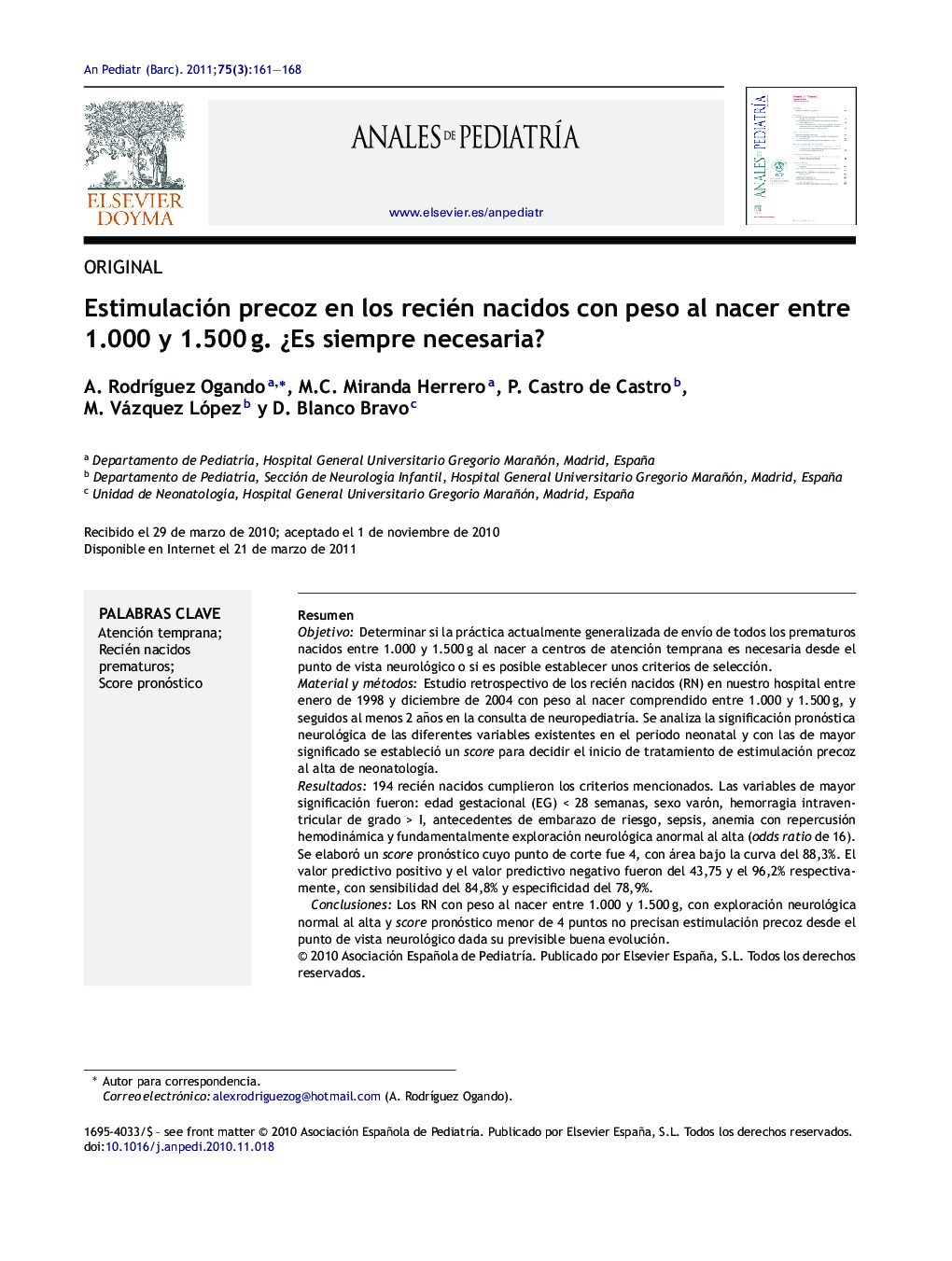| کد مقاله | کد نشریه | سال انتشار | مقاله انگلیسی | نسخه تمام متن |
|---|---|---|---|---|
| 4142241 | 1272364 | 2011 | 8 صفحه PDF | دانلود رایگان |

ResumenObjetivoDeterminar si la práctica actualmente generalizada de envío de todos los prematuros nacidos entre 1.000 y 1.500 g al nacer a centros de atención temprana es necesaria desde el punto de vista neurológico o si es posible establecer unos criterios de selección.Material y métodosEstudio retrospectivo de los recién nacidos (RN) en nuestro hospital entre enero de 1998 y diciembre de 2004 con peso al nacer comprendido entre 1.000 y 1.500 g, y seguidos al menos 2 años en la consulta de neuropediatría. Se analiza la significación pronóstica neurológica de las diferentes variables existentes en el periodo neonatal y con las de mayor significado se estableció un score para decidir el inicio de tratamiento de estimulación precoz al alta de neonatología.Resultados194 recién nacidos cumplieron los criterios mencionados. Las variables de mayor significación fueron: edad gestacional (EG) < 28 semanas, sexo varón, hemorragia intraventricular de grado > I, antecedentes de embarazo de riesgo, sepsis, anemia con repercusión hemodinámica y fundamentalmente exploración neurológica anormal al alta (odds ratio de 16). Se elaboró un score pronóstico cuyo punto de corte fue 4, con área bajo la curva del 88,3%. El valor predictivo positivo y el valor predictivo negativo fueron del 43,75 y el 96,2% respectivamente, con sensibilidad del 84,8% y especificidad del 78,9%.Conclusiones: Los RN con peso al nacer entre 1.000 y 1.500 g, con exploración neurológica normal al alta y score pronóstico menor de 4 puntos no precisan estimulación precoz desde el punto de vista neurológico dada su previsible buena evolución.
ObjectiveTo determine whether the currently widespread practice of sending all premature infants with birth weight between 1,000 and 1,500 g to early care centres is necessary from a neurological point of view, or if it is possible to establish selection criteria.Material and methodsA retrospective study of newborns (NB) at our hospital between January 1998 and December 2004 with birth weight between 1,000 and 1,500 g, and followed up for at least two years in a paediatric neurology clinic. We analysed the prognostic significance of the different neurological variables in the neonatal period, and those of greater significance were set at a score for deciding the start of early stimulation treatment on discharge from neonatology.ResultsA total of 194 infants met the above criteria. The most significant neurological prognostic variables were: gestational age < 28 weeks, male sex, intraventricular haemorrhage grade > I, history of high risk pregnancy, sepsis, anaemia with haemodynamic repercussion and fundamentally abnormal neurological examination at discharge (odds ratio of 16). A prognostic score was developed with a cut-off of 4 points, with an area under the curve of 88.3%. The positive predictive value and negative predictive value were 43.75% and 96.2%, respectively, with 84.8% sensitivity and 78.9% specificity.ConclusionsThe newborns with birth weight between 1,000 and 1,500 g and normal neurological examination at discharge, with a score of less than 4 points, do not require early stimulation treatment from a neurological standpoint, given its predictable good outcome.
Journal: Anales de Pediatría - Volume 75, Issue 3, September 2011, Pages 161–168